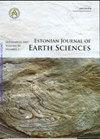爱沙尼亚Ohesaare岩心Ludlow中ludfordian碳同位素偏移区间的生物和化学地层学研究
IF 0.8
4区 地球科学
Q4 GEOSCIENCES, MULTIDISCIPLINARY
引用次数: 0
摘要
多年来,Ohesaare岩心剖面及其丰富的化石组合吸引了研究人员对东波罗的海志留纪地层学提出了各种各样的想法,尽管在勒德洛区间出现了几个沉积缺口。其中一个空白已经从Ohesaare记录中删除了古生代碳同位素历史上最重要的事件-中卢德福尔碳同位素偏移(MLCIE),该事件部分伴随着生物和海洋事件。在我们的研究中,我们对几壳虫、牙形刺、介形虫和脊椎动物微遗骸进行了详细的分布分析,目的是记录有关主要在MLCIE之前某些环境事件水平的证据。为此,将托古组划分为5个工作单元。第一个结果表明,在托尔古组最上部的一个缺口可能是缺失的MLCIE的水平。为了验证这一点,我们比较了Ohesaare与哥特兰(瑞典)和Kurzeme(拉脱维亚)的化石分布模式,包括Uddvide(哥特兰)和Ventspils(拉脱维亚)岩心剖面的δ13C数据。波罗的海和波西米亚的数据一致表明,MLCIE位于Ozarkodina crispa牙形刺生物带之下。然而,哥特兰的一些报告显示,在较高的地层中也有峰值;在其他地方偶尔发现的crispa ozs可能会对这些发现产生一些怀疑,并在讨论上卢德福尔的对比时引起一些生态地层学上的关注。本文章由计算机程序翻译,如有差异,请以英文原文为准。
A bio- and chemostratigraphic search for the Mid-Ludfordian Carbon Isotope Excursion interval in the Ludlow of the Ohesaare core, Estonia
For years, the Ohesaare core section and its rich fossil assemblages have enticed researchers to suggest various ideas about Silurian stratigraphy in the East Baltic despite several sedimentary gaps occurring through the Ludlow interval in particular. One of the gaps has removed from the Ohesaare record the most important event in the Palaeozoic history of carbon isotopes – the MidLudfordian Carbon Isotope Excursion (MLCIE), which is partly accompanied by the Lau biotic and oceanic events. In our research, we have performed a detailed distribution analysis of chitinozoans, conodonts, ostracodes and vertebrate microremains with the aim of documenting the evidence regarding the levels of certain environmental events largely preceding the MLCIE. For this purpose, the Torgu Formation was subdivided into five working units. The first results indicate a gap within the uppermost part of the Torgu Formation as a possible level for the missing MLCIE. In order to verify this, we compared the fossil distribution pattern in Ohesaare with that on Gotland (Sweden) and in Kurzeme (Latvia), including δ13C data from the Uddvide (Gotland) and Ventspils (Latvia) core sections. Both Baltic and Bohemian data show rather unanimously that the MLCIE is located below the Ozarkodina crispa conodont Biozone. However, some reports from Gotland show peak values also in higher strata; occasional records of Oz. crispa from other places may cast some doubt on these findings and raise some ecostratigraphical concerns when discussing upper Ludfordian correlation.
求助全文
通过发布文献求助,成功后即可免费获取论文全文。
去求助
来源期刊

Estonian Journal of Earth Sciences
地学-地球科学综合
CiteScore
1.50
自引率
9.10%
发文量
11
审稿时长
>12 weeks
期刊介绍:
The Estonian Journal of Earth Sciences is an international scientific open access journal published by the Estonian Academy of Sciences in collaboration with the Tallinn University of Technology, the University of Tartu, the Estonian University of Life Sciences and the Talllinn University.
The journal publishes primary research and review papers in the English language. All articles are provided with short Estonian summaries.
All papers to be published in the journal are peer reviewed internationally.
The journal is open for publications in all fields of Earth sciences, including besides different geological sensu lato disciplines, also geography and oceanography having certain connection with our part of the world, North Europe and the Baltic area in particular.
 求助内容:
求助内容: 应助结果提醒方式:
应助结果提醒方式:


